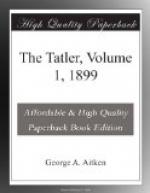[Footnote 96: In a copy of the original edition of the Tatler, with MS. notes written early in the last century, which was sold at Messrs. Sotheby’s, in April, 1887, the ladies here described were said to be Mrs. Chetwine and Mrs. Hales respectively. Mrs. Hales was a maid of honour who married Mr. Coke, vice-chamberlain, in July, 1709 (Luttrell’s “Brief Relation,” vi. 462); “Mrs. Chetwine” was probably the wife of William Richard Chetwynd, afterwards third Viscount Chetwynd, who married Honora, daughter of John Baker, Consul at Algiers; or the wife of his brother Walter, M.P. for Stafford, and Master of the Buckhounds. In 1717, Lady M. W. Montagu, describing a week spent by a fashionable lady, said, ’Friday, Mrs. Chetwynd’s, &c.; a perpetual round of hearing the same scandal’ (Pope’s Works, ix. 385).]
[Footnote 97: Charles Jervas, portrait painter (died 1739), became principal painter to George I. and George II. He also made a translation of “Don Quixote,” first published in 1742.]
[Footnote 98: A translation of Owen McSwiney (1709) from the Italian of Scarlatti.]
[Footnote 99: In the Spectator (Nos. 1, 5, 13, &c.) Addison often wrote against the Italian opera. In 1706, Dennis published “An Essay on the Operas after the Italian Manner, which are about to be established on the English Stage: with some reflections on the damage which they may bring to the Public.” He traces to the recent alterations in the entertainments of the stage, the fact that familiar conversation among all classes was confined to two points, news and toasting, neither of which required much intelligence.]
[Footnote 100: The street cries of 1709 are described in Lauron’s “Habits and Cries of the City of London.” They included “Any card-matches or save-alls” and “Twelve-pence a peck, oysters.”]
[Footnote 101: Matches made by dipping pieces of card in melted sulphur. In the Spectator (No. 251), Addison speaks of vendors of card-matches as examples of the fact that those made most noise who had least to sell.]
[Footnote 102: In vol. ii. of Dr. W. King’s Works (1776) is “An Essay on the Invention of Samplers, by Mrs. Arabella Manly, schoolmistress at Hackney.”]
[Footnote 103: May Fair was abolished in 1709, after it had on several occasions been presented as a nuisance by the Grand Jury at Westminster. This fair was granted by King James II. under the Great Seal, in the fourth year of his reign, to Sir John Coell and his heirs for ever, in trust for Henry Lord Dover and his heirs for ever, to be held in the field called Brookfield, in the parish of St. Martin’s, Westminster, to commence on the first day of May, and to continue fifteen days yearly. It soon became the resort of the idle, the dissipated, and the profligate, insomuch that the peace-officers were frequently opposed in the performance of their duty; and, in the year 1702, John Cooper, one of the constables, was killed, for which a fencing-master, named Cook, was executed. (See also No. 20.) The fair was revived under George I., but was finally abolished through the exertions of the sixth Earl of Coventry.]




